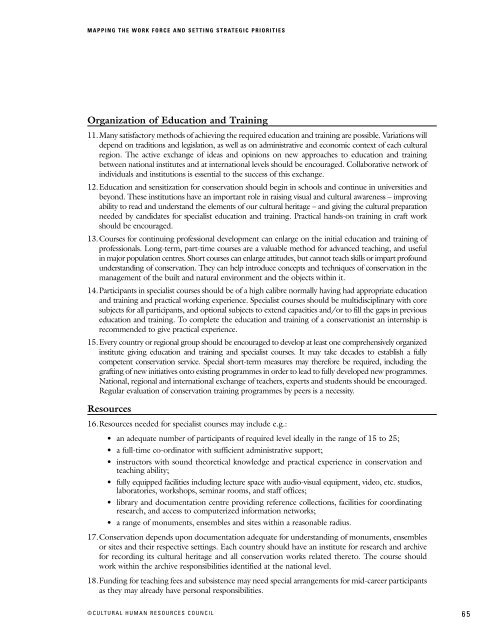Human Resources in Canada's Built Heritage Sector: Mapping the ...
Human Resources in Canada's Built Heritage Sector: Mapping the ...
Human Resources in Canada's Built Heritage Sector: Mapping the ...
- No tags were found...
You also want an ePaper? Increase the reach of your titles
YUMPU automatically turns print PDFs into web optimized ePapers that Google loves.
MAPPING THE WORK FORCE AND SETTING STRATEGIC PRIORITIESOrganization of Education and Tra<strong>in</strong><strong>in</strong>g11.Many satisfactory methods of achiev<strong>in</strong>g <strong>the</strong> required education and tra<strong>in</strong><strong>in</strong>g are possible. Variations willdepend on traditions and legislation, as well as on adm<strong>in</strong>istrative and economic context of each culturalregion. The active exchange of ideas and op<strong>in</strong>ions on new approaches to education and tra<strong>in</strong><strong>in</strong>gbetween national <strong>in</strong>stitutes and at <strong>in</strong>ternational levels should be encouraged. Collaborative network of<strong>in</strong>dividuals and <strong>in</strong>stitutions is essential to <strong>the</strong> success of this exchange.12.Education and sensitization for conservation should beg<strong>in</strong> <strong>in</strong> schools and cont<strong>in</strong>ue <strong>in</strong> universities andbeyond. These <strong>in</strong>stitutions have an important role <strong>in</strong> rais<strong>in</strong>g visual and cultural awareness – improv<strong>in</strong>gability to read and understand <strong>the</strong> elements of our cultural heritage – and giv<strong>in</strong>g <strong>the</strong> cultural preparationneeded by candidates for specialist education and tra<strong>in</strong><strong>in</strong>g. Practical hands-on tra<strong>in</strong><strong>in</strong>g <strong>in</strong> craft workshould be encouraged.13.Courses for cont<strong>in</strong>u<strong>in</strong>g professional development can enlarge on <strong>the</strong> <strong>in</strong>itial education and tra<strong>in</strong><strong>in</strong>g ofprofessionals. Long-term, part-time courses are a valuable method for advanced teach<strong>in</strong>g, and useful<strong>in</strong> major population centres. Short courses can enlarge attitudes, but cannot teach skills or impart profoundunderstand<strong>in</strong>g of conservation. They can help <strong>in</strong>troduce concepts and techniques of conservation <strong>in</strong> <strong>the</strong>management of <strong>the</strong> built and natural environment and <strong>the</strong> objects with<strong>in</strong> it.14.Participants <strong>in</strong> specialist courses should be of a high calibre normally hav<strong>in</strong>g had appropriate educationand tra<strong>in</strong><strong>in</strong>g and practical work<strong>in</strong>g experience. Specialist courses should be multidiscipl<strong>in</strong>ary with coresubjects for all participants, and optional subjects to extend capacities and/or to fill <strong>the</strong> gaps <strong>in</strong> previouseducation and tra<strong>in</strong><strong>in</strong>g. To complete <strong>the</strong> education and tra<strong>in</strong><strong>in</strong>g of a conservationist an <strong>in</strong>ternship isrecommended to give practical experience.15.Every country or regional group should be encouraged to develop at least one comprehensively organized<strong>in</strong>stitute giv<strong>in</strong>g education and tra<strong>in</strong><strong>in</strong>g and specialist courses. It may take decades to establish a fullycompetent conservation service. Special short-term measures may <strong>the</strong>refore be required, <strong>in</strong>clud<strong>in</strong>g <strong>the</strong>graft<strong>in</strong>g of new <strong>in</strong>itiatives onto exist<strong>in</strong>g programmes <strong>in</strong> order to lead to fully developed new programmes.National, regional and <strong>in</strong>ternational exchange of teachers, experts and students should be encouraged.Regular evaluation of conservation tra<strong>in</strong><strong>in</strong>g programmes by peers is a necessity.<strong>Resources</strong>16.<strong>Resources</strong> needed for specialist courses may <strong>in</strong>clude e.g.:• an adequate number of participants of required level ideally <strong>in</strong> <strong>the</strong> range of 15 to 25;• a full-time co-ord<strong>in</strong>ator with sufficient adm<strong>in</strong>istrative support;• <strong>in</strong>structors with sound <strong>the</strong>oretical knowledge and practical experience <strong>in</strong> conservation andteach<strong>in</strong>g ability;• fully equipped facilities <strong>in</strong>clud<strong>in</strong>g lecture space with audio-visual equipment, video, etc. studios,laboratories, workshops, sem<strong>in</strong>ar rooms, and staff offices;• library and documentation centre provid<strong>in</strong>g reference collections, facilities for coord<strong>in</strong>at<strong>in</strong>gresearch, and access to computerized <strong>in</strong>formation networks;• a range of monuments, ensembles and sites with<strong>in</strong> a reasonable radius.17.Conservation depends upon documentation adequate for understand<strong>in</strong>g of monuments, ensemblesor sites and <strong>the</strong>ir respective sett<strong>in</strong>gs. Each country should have an <strong>in</strong>stitute for research and archivefor record<strong>in</strong>g its cultural heritage and all conservation works related <strong>the</strong>reto. The course shouldwork with<strong>in</strong> <strong>the</strong> archive responsibilities identified at <strong>the</strong> national level.18.Fund<strong>in</strong>g for teach<strong>in</strong>g fees and subsistence may need special arrangements for mid-career participantsas <strong>the</strong>y may already have personal responsibilities.©CULTURAL HUMAN RESOURCES COUNCIL65










